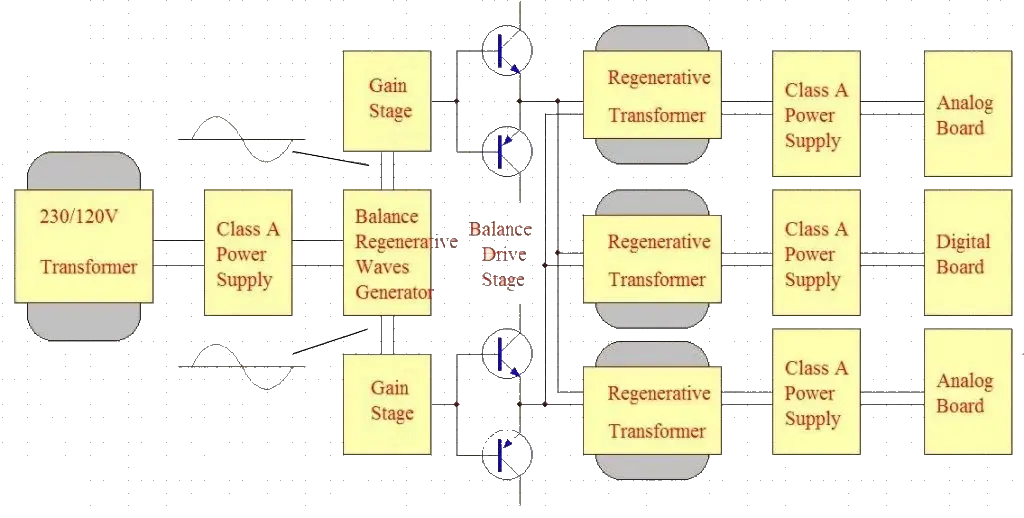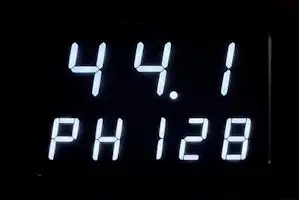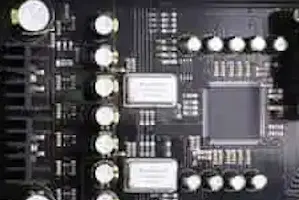Technical Specifications
| Technical Specifications |
|---|
| Product type | R2R DAC |
| DAC Chips | 4x PCM1704UK |
| Inputs | 1x AES/EBU
1x Optical Toslink
1x Coaxial
1x BNC
1x I2S via HDMI LVDS
1x USB-B
1x Port for software update |
| Outputs | 1x Single-ended RCA
1x Balanced XLR
1x Balanced ACSS |
| Signal-to-noise ratio (SNR) | > 120dB |
| Output impedance | < 5Ω |
| Output level | RCA : 2.5V
XLR : 5V
ACSS : 2+2mA |
| Frequency response | 20Hz – 20kHz |
| Total harmonic distortion (THD) | < 0.01% |
| Input sensitivity | Coaxial 75Ω : 0.5Vp-p
Optical : 19dBm |
| Compatible OS (USB) | Windows, OSX, Linux, ISO |
| Supported sampling rates | USB, I2S : PCM up to 32bit 384kHz
Coaxial, Optique : PCM up to 24bit 192kHz |
| General |
|---|
| Supply voltage | 220-240V AC 50/60 Hz |
| Consumption | 48W |
| Dimensions | 430 x 445 x 80mm |
| Weight | 12kg |
| Color | Black |
| package | 1x AUDIO-GD HE-8
1x Power cable
1x USB cable
1x Remote control |
NOS & OVERSAMPLING MODE
The R8 offers several Oversampling or NOS (Non-Oversampling) modes. If you wish to choose Oversampling, simply select the value “O”. If you want to choose the NOS then you have to choose the value “N”. You can then select one of the following modes to adapt the playback to your listening experience
ULTRA FAST SIGNAL PROCESSING
FPGA stands for Programmable Array Logic. Nowadays the FPGA is widely adopted in audio devices. The internal hardware design is fully controlled by complex software. A huge advantage is the fact the software in the FPGA can easily be upgraded offering new capabilities or improve the performance of the device without replacing any hardware. Versatile and future proof design.
- High performance SPDIF interface, replacing traditional less good performing SPDIF interface chips like DIR9001, WM8805 or AK411X,etc.
- Full re-clocking process with FIFO design applicable on all inputs. This way the output data keeps fully synchronized with the clock signal to reject any jitter.
- Built in 2X, 4X and 8X oversampling and digital filters and on top of this 4 different true NOS (only analog 6dB filtering) modes. To completely configure the sound according to your taste.
ANALOGUE OUTPUT STAGES
The analog output stages are as important, they have a tremendous influence on the final sound quality. After d/a conversion by the R2R D/A modules the analogue signal is transported by fully discrete matched-transistor output stages; DC-coupled design with first class through-hole components. No SMD compon ents are applied in the analogue section. The high speed unique ACSS ((Audio-gd Current Signal System) output stages are non-feedback and current driven. Unique performance because almost all other designs need to convert the signal multiple times from and to current and/or voltage, resulting in less detailed and less transparent sound-stage The output buffers are single ended FET; two stages in parallel to reach very low output impedance. All output stages are in pure class A without (negative) feedback to achieve purest and a real live sound reproduction. The 4 OPA op-amp’s are DC servos, this way no coupling-capacitors are needed and DC output is automatically biased. The listener will be presented a strikingly transparent and neutral sound.
ACSS – Current Amplification
Audio-GD has developed an advanced current-driven amplifier technique. Also known as ACSS, Audio-GD Current System Signal. This special technique ensures that the signal travels a much shorter path and that ensures a more transparent, faster and more neutral reproduction. A similar technique is used by, for example, KRELL. The Current Conveyor technology mostly components are the current mirror. The Current Conveyor technology isn’t a new technology, at 1966 , professor K.C. Smith and A.S.Sedra publish the concept “current mode analogue circuits “ .
REGENERATIVE POWER SUPPLY
An integrated regenerative power supply is a proprietary electric generator built into the unit to avoid any noise from main power and deliver ultra-low noise and clean AC wave to feed the preamp. It will regenerate the main power and block noise from the power line, this way the preamp is able to reproduce the most neutral and analog sound you can imagine. First a transformer converts main voltage. DC conversion is done by class A PSUs power supplies.
A discrete balanced regenerative wave generator produces the new ultra-low noise wave form at 400Hz. The 400Hz frequency was chosen because they have better efficiency compared to traditional 50Hz and at this frequency, 400Hz, it will boost the sound to reproduce real and pleasant analog sound. The balanced gain amps with powerful output stages are driving the regenerative transformers to produce the extreme clean AC power. The extreme regenerated clean AC power is send to separate class A PSUs power supplies for both left and right channel. The discrete class-A DC power supply with high input impedance will avoid any noise and allow the amplifier stages to have low output impedance at very high speed and linear at frequency spectrum.

%20(Black)?unique=c6ecc2b)




